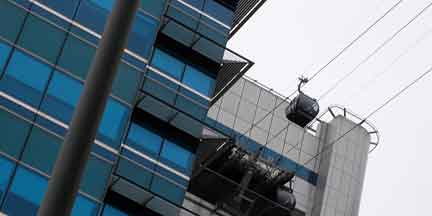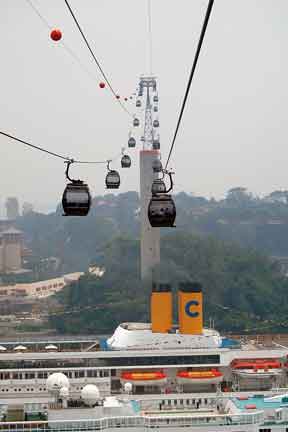
Last week I had the opportunity to tour the Sentosa Island Cable Car in Singapore. Special thanks to Andrew Seh and Dominic Teo, who gave me the tour, answered questions and provided some insight into this system. All images by Steven Dale.
The Sentosa Island Gondola is one of the world’s oldest urban gondola transit systems. Commonly referred to as the Sentosa Island Cable Car (it’s an MDG gondola), the system is utterly normal in most respects but was a pioneer in two very important ways: It was the first system to ever span a major port/harbour and; it was the first to ever implement an intermediary station within the building envelope of a skyscraper.

The Sentosa Cable Car was the first in the world to locate an intermediary station on the upper floor of a skyscraper. The intermediary station is located on the 15th floor of a harbor office tower.
Originally opened in 1974, the system was designed as a means to carry locals and tourists from Mount Faber on Singapore’s south shore, across the harbour to Sentosa Island – then a growing recreation destination. As Sentosa developed into a major resort destination, connections to the island became increasingly important. Now, the cable car competes with a boardwalk and APM system.
As a result, the vast majority of users are tourists. Andrew Seh, Assistant Manager of the cable car estimates that of the roughly 2,000 daily riders the system carries, approximately 80% are tourists. This shouldn’t surprise. As a round-trip ticket on the cable car is $26 SGD, locals wishing to visit Sentosa would logically opt for either the boardwalk or monorail options. The Sentosa system is therefore pure Toy for Tourists.
Nevertheless, the system was popular enough to warrant an entire overhaul and the system was closed last year for 9 months in order to upgrade and rehabilitated the line. Typically an overhaul such as this should only take around 6 months, but system planners opted to upgrade the outdated BDG system with a contemporary MDG line.
As an MDG system requires one single cable to provide both support and propulsion, the pressures and tensions on that cable – as well as on stations and towers – are greater than those found in a standard BDG system (where one cable provides support and the other propulsion).
As a result, the technology switch involved significant changes to pre-existing towers and stations, with new concrete foundations poured throughout – hence, the 9 month rebuild period.
This change also meant that while the electro-mechanical components of the gondola were only $22m SGD (~18m USD), the entire rebuild cost $36m SGD (~26m USD), a 63%premium.
Even still, at roughly $21m USD per kilometer (all in) the technology proves itself competitive with other fixed cost transit systems.
As stated earlier, this system is utterly common. It’s statistics are nothing impressive and don’t cause anyone any large degree of pause:
- Capacity of 2,000 pphpd – but can be increased to 2,800 with a flick of a switch.
- Standard operating speed of 11 km/hr. The system can run at 18 km/hr, but the touristic nature of the system implores operators to maintain a speed that allows riders to get value for their money.
- 1.7 km long.
- Can operate safely in 50 km/hr winds.
- Vehicle capacity of 8.
What does give pause is the unique 7-star VIP cabin.
When this system reopened last fall, media attention focused almost exclusively on the VIP cabin as though it were the second coming of the Messiah. As someone who actually got to ride the VIP cabin, I’d like to suggest the attention was a little bit overdrawn.
The VIP cabin is nice, sure, but the amenities are rather thin. The VIP cabin is the sole one in the fleet equipped with a glass-bottomed floor and studded with Swarovski crystals. And whereas the other cabins have seating for 8 on a pretty standard bench configuration, the VIP cabins only seat four – but in rather plush black, leather seats. Ipod dock and champagne chiller are also included.
But that’s about it.
Booking the VIP cabin is not for cheap. At $888 SGD (~$700 USD), this is easily one of the most expensive gondola rides we’ve ever seen and heard of. Granted, that $888 includes champagne for four, dinner for four at the Mount Faber restaurant and unlimited and exclusive use of the VIP cabin. But even with dinner and champagne, the price is steep – particularly as the cabins aren’t equipped with air conditioning, a confusing oversight which no one could adequately explain to me.
Nevertheless, cable car officials informed me that each month a few groups do actually choose to book the VIP cabin – no doubt as a means to get to the Sentosa Island Casino where the reckless spending of money is considered an art and a virtue.
Tomorrow I’ll discuss the urban design implications of the Sentosa Island Gondola.




8 Comments
steven, are all the cabins black and somewhat ominous looking? (like in the second to last image)
@ Rose,
Yes, all cabins are black.
also, in the last image, of the VIP cabin there’s a really fuzzy cabin behind it, did the MDG system have a lot of sway? did anyone note a big difference in rider experience between the old BDG and the new monocable?
@ Rose,
The reason for the fuzzy cabin was because the VIP cabin has darkened windows – to reinforce the VIP image. There was also a forest fire in nearby Sumatra that caused the sky to be very dark. As a result, I needed to use a long shutter speed to get the photos I wanted. Hence the blurred out gondola.
No major sway to report. Some – as it was a very windy day – but nothing major.
Isn’t the 7-star VIP cabin missing a “deluxe” and “super-duper” in the name? Or at least VRP?
Well, who knew the London Eye could be so horizontal at the same ticket-price 😉 I didn’t know tourism took that line so much over. Really good to know.